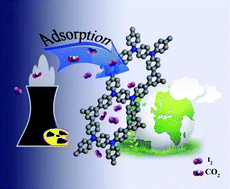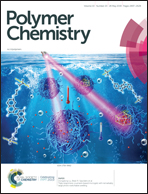Ultrahigh volatile iodine capture by conjugated microporous polymer based on N,N,N′,N′-tetraphenyl-1,4-phenylenediamine†
Abstract
Conjugated microporous polymers have raised considerable interest in various fields such as gas adsorption, iodine adsorption, chemosensors, photocatalysis, and electronics. Herein, three multifunctional electron-rich conjugated microporous polymers (CMP-LS4–6) were facilely synthesized via Suzuki and Sonogashira polymerization reactions of N,N,N′,N′-tetrakis(4-bromophenyl)benzene-1,4-diamine with aromatic borates and 1,3,5-triethynylbenzene, respectively. These CMP-LSs possess intrinsic porosity (BET surface areas up to 1185 m2 g−1) as well as moderate CO2 adsorption capacity. Benefiting from their good pore properties and expanded nitrogen-rich π-conjugated networks, CMP-LS4–6 display excellent I2 uptakes of 3.32, 4.40 and 2.44 g g−1 in a vapor atmosphere, respectively. The release processes of I2@CMP-LS4–6 into ethanol and upon heating were explored, and these CMP-LSs exhibit outstanding capacity for the reversible uptake of iodine. The results of the iodine adsorption experiments show that CMP-LS4–6 can be used as iodine sorbents to treat environmental problems; meanwhile, this work provides ideas for designing effective iodine adsorbents. Furthermore, CMP-LS4 and CMP-LS5 exhibit solvatochromic fluorescence behavior with increasing polarity of aprotic solvents.



 Please wait while we load your content...
Please wait while we load your content...